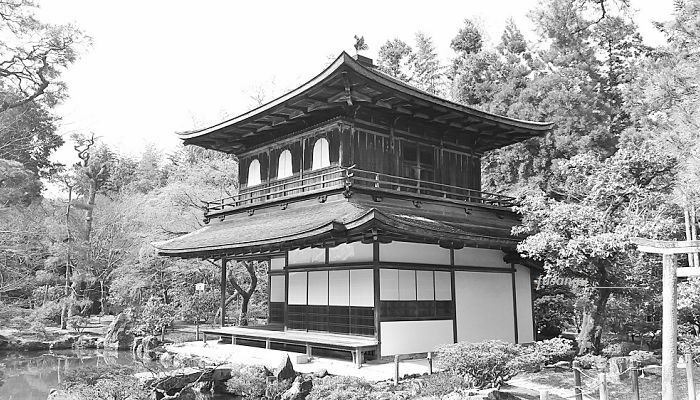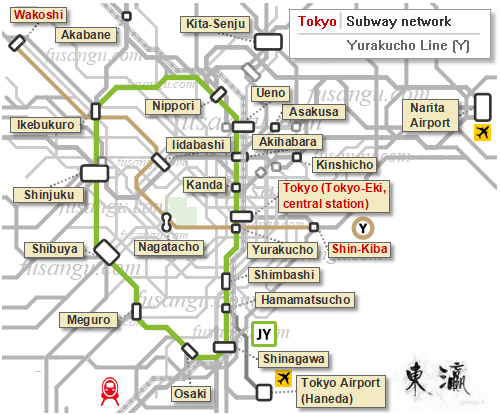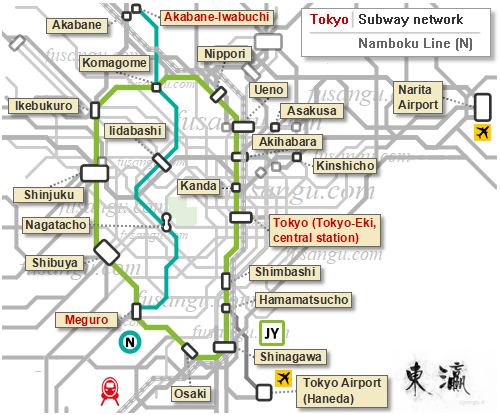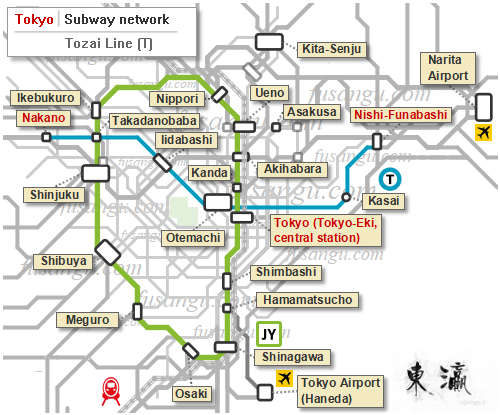City buses offer the cheapest and overall most convenient way to get around in Kyoto. A few lines specifically aim the needs of visitors who travel for the purpose of sightseeing. Among them are the three Raku lines.
In this page we briefly describe itineraries that require few transfers by means of Line 100. No other means of transport is required, though in many cases you may want to include a few walking tours.
⇒ Notice (August 2024)
Kyoto City Bus Linea 100 is currently out of service. Many other bus lines serve the same route; among those, of particular usefulness for visitors are Line 5, Line 86 and Line 206.
Kyoto City Bus Line 100: essential information

Line 100 is one of the three Raku Bus lines. These lines are aimed at satisfying the needs of travellers as they link many of Kyoto’s main sightseeing spots, attractions, landmarks and popular neighbourhoods.
The three Raku lines describe a circular path connecting three major places of interest:
-
Kyoto Station;
-
Ginkaku-Ji Temple;
-
Kinkaku-Ji Temple.
Regardless of how long your stay in Kyoto will be, you are likely to pass by all these places.
Line 100 serves the eastern part of the city, in particular the districts comprised between Kyoto Station and Ginkaku-Ji, major temple and landmark located in southern Sakyo.
Of particular interest is the central section, where Line 100 gets through southern Higashiyama and Gion. These are among the most interesting parts of the city to visit, an area dense with cultural heritage and fascinating architecture where you will enjoy walking, wandering, exploring and also getting lost.
The number of sightseeing places, especially the ones of cultural significance, that are served by Line 100 is so big that you may even spend 2 or 3 days by solely getting around on buses of this line.
If you travel under strict time constraints you will most likely choose to limit the scope of your programme and opt for a less intensive schedule.
In this page we outline a one-day and a two-day itineraries along Line 100. Both programmes are very suitable for short journeys (3-5-day itineraries).
Notable railway stations along the line
Beside Kyoto Station, the city’s main railway hub, linked to the national shinkansen (high-speed) railway network, Line 100 serves a number of minor railway stations of local lines. These can be of interest, especially to those who reach Kyoto from Osaka. One of these stations is Shichijo-Eki, served by the Keihan Main Line, a railway connection between Eastern Kyoto and Central Osaka.
Kyoto Bus Line 100: route
As anticipated, Line 100 serves a fundamental sightseeing route. Moreover, it connects two areas where first-time travellers often choose to find their lodgings, i.e., the surroundings of Kyoto Station and Gion (as well as nearby Kawaramachi, across the river).
We suggest you spend some time on a map and find reference points. Doing so will make things easier when you have reached Kyoto. Detailed material is available at the tourist office of Kyoto Station, really outstanding as for quality and variety.
In the following prospect we list the stops that can be useful for organising itineraries along Line 100.
Line Raku 100 (Kyoto-shi Basu)Relation: Kyoto Station - Ginkaku-Ji |
|
|
Bus stop |
Places of interest (distance, in metres) Interchange |
|
Kyoto-Eki-mae |
Kyoto Station (100 m) |
|
Nanajo Kawaramachi |
Shosei-En Gardens (500 m) |
|
Nanajo Keihan-mae |
Kamo River (100 m) Kiyamachi-dori street (300 m) Shosei-En Gardens (900 m)
Shichijo Station (Keihan Main Line) (150 m) Line 南5: for Fushimi Inari Taisha |
|
Hakubutsukan Sanjusangendo-mae |
Sanjusangen-Do (100 m) Kyoto National Museum (100 m) |
|
Higashiyama-Nanajo |
Southern Higashiyama Chishaku-In (200 m) |
|
Gojo-zaka |
Kiyomizu-dera (900 m) Sannen-zaka (600 m) |
|
Kiyomizu-michi |
Kiyomizu-dera (900 m) Sannen-zaka (500 m) Ninen-zaka (500 m) |
|
Gion |
Yasaka-Jinja (100 m) Maruyama Park (500 m) Chion-In (700 m)
Line 12: for Kinkaku-Ji Line 203: for Shinnyo-Do |
|
Higashiyama-Sanjo |
Shoren-In (700 m)
Higashiyama Station (Tozai Line, subway) (200 m) Line 5: for Eikan-Do and Nanzen-Ji |
|
Okazakikoen Bijutsukan / Heian-Jingu-mae |
Heian-Jingu (1.000 m) |
|
Okazakikoen Dobutsuen-mae |
Kyoto City Zoo |
|
Okazaki Michi |
|
|
Higashi Tennocho |
Nanzen-Ji (800 m) Eikan-Do (800 m)
Line 93: for Arashiyama |
|
Miyanomaecho |
|
|
Honenin-cho |
Honen-In (600 m) |
|
Ginkakuji-mae |
Ginkaku-Ji (500 m) Philosopher’s Path (200 m) |
|
Ginkakuji-michi |
Nomura Museum ( 200 m)
Line 102: for Kinkaku-Ji |
|
Kinrin Shako-mae |
|
|
Jingu Michi |
|
|
(*) Line 100 provides connection to a far larger number of lines. Here we have simply mentioned the lines that are typically used by tourists. |
|
Travel times
Travel duration, approximate, from Kyoto Station:
-
Kiyomizu-dera: 25 minutes (15 minutes by bus; 10 minutes on foot);
-
Gion (Yasaka-Jinja): 21 minutes (20 minutes by bus; 1 minute on foot);
-
Heian Shrine: 30 minutes (26 minutes by bus; 4 minutes on foot);
-
Ginkaku-Ji: 48 minutes (40 minutes by bus; 8 minutes on foot).
For each relation we have listed the minimum duration of the journey. Transfers may take more time in high season, during the cherry blossom or national holidays when traffic is a frequent occurrence.
Tariffs
Line 100 belongs to the Kyoto-Shi Basu network (the municipal network). Therefore tariffs are fixed and amount to 230 yen for an adult and 120 yen for a child (of 12 years of age or below).
Differently from ordinary bus lines, tariffs are collected when you get on the bus (through the front door near the driver).
If you plan on using the public transportation system many times, you may take advantage of the one-day pass, which costs 1.100 yen and allows for unlimited use of bus and subway lines.
Alternatives to Kyoto Bus Line 100
In high season buses of the Line 100 are often crowded. Delays are possible and the journey can become unpleasant.
Aside from opting for the taxi, you may resort to other alternative solutions:
-
Transfers by subway and by bus: if you wish to reach Ginkaku-Ji from Kyoto Station you may take the subway (Karasuma Line) up to Imadegawa Station. Here you can transfer to a bus of Line 102;
-
Staying in the city centre of Kamigyo: a good option is to stay in the city centre. Cheaper lodgings can be found in Kamigyo, a pleasant neighbourhood where you can see the ordinary non-touristy city. If you stay in Kamigyo you can get around by bicycle. Many traditional guest houses offer bicycle rentals at a cheap price. Make sure you book your hotel well in advance;
-
Re-organising the itinerary: another option is to organise transfers in a different way. The Keihan Main Line offers a convenient way to move between different locations in Higashiyama. The line runs parallel to Kamo River. If you do not mind some walking, getting around by train can be a good option to avoid crowded buses. This is particularly effective if you visit Kyoto with a day-excursion from Osaka. Stations along the southern part of Higashiyama are quite close to important sightseeing spots (the only exception being Kiyomizu-dera). Ginkaku-Ji can be reached from Demachiyanagi Station with a 20-30 minute walk.
Recommended itinerary along Line 100
We briefly outline a one-day and two-day itinerary along the bus Line 100. We assume you start your journey from Kyoto Station. It is very easy to arrange for itineraries with different starting points.
One-day itinerary
The following is the programme for a one-day itinerary through Higashiyama and southern Sakyo. It is most suitable for a three-day visit in Kyoto.
One day in Kyoto: itinerary along Line 100Relation: Kyoto Station - Ginkaku-Ji Temple |
|
|
Bus stop |
Sightseeing places |
|
Kyoto-Eki-mae |
Kyoto Station (100 m) |
|
Gojo-zaka |
Kiyomizu-dera (900 m) |
|
|
Walking tour; starting point: Kiyomizu-dera Destinations:
|
|
Gion |
Yasaka Shrine (100 m) |
|
Ginkakuji-mae |
Ginkaku-Ji (500 m) Philosopher’s Path (200 m) |
Related articles:
Main article: Kyoto 3-day itinerary
Itineraries along the Keihan Main Line: Southern Higashiyama | Northern Higashiyama and Sakyo

There are quite a few ways to move between Kyoto Station and Ginkaku-Ji. Along the journey it is possible to add numerous stops for visiting some of the city's most interesting districts and places of interest.
The route through Higashiyama is a classic and certainly the most typical itinerary for a first-time traveller. Even if you choose this route, there will be plenty of possibilties regarding how to plan the itinerary. Another choice is to go through the city centre.
Buses offer the easiest way to get from Kyoto Station to Ginkaku-Ji. If you want to save time you may consider using the subway too.
Ginkaku-Ji is a major temple located in Southern Sakyo, just north of Higashiyama district. Regarded as a masterpiece of art, the temple exerted a great influence on the development of Japanese culture. Visiting Ginkaku-Ji is a must, even for a short-stay programme.
Distances
The distance between Kyoto Station and Ginkaku-Ji measured along major roads amounts to a little less than 10 km. As such, it is perfectly compatible for a full day itinerary on foot, especially if you consider that you can set your starting point in locations in Southern Higashiyama, typically the Sanjusangen-do or Kiyomizu-dera.
Most travellers who do not suffer from any mobility limitations will find the walking pleasant and enjoyable.
How to get to Ginkaku-Ji from Kyoto Station
Ginkaku-Ji is served by a fair number of buses, including some of the most useful lines, i.e. Line 5 (from Kyoto Station) and 204 (from Kitaoji Station via Kinkaku-Ji).
By bus
The following lines serve the Kyoto Station - Ginkaku-Ji route:
-
Kyoto City Bus 5: through Higashiyama (via Gion);
-
Kyoto City Bus 17: through the centre of Kyoto (Nakagyo, Kamigyo).
Bus Line 17 (around 45 minutes, 230 yen):
-
1) Bus Line 17: Kyoto-Eki-mae - Ginkakuji-michi; 30 minutes, 230 yen;
-
2) On foot: 10 minutes.
By subway and bus
Furthermore, if you are pressed for time and you do not want to stick to buses only, you may opt for using the subway between Kyoto Station and Imadegawa Station. The remaining leg (Imadegawa Station - Ginkaku-Ji) is covered by Line 204.
Subway and bus (around 45 minutes, 490 yen):
-
1) Karasuma Line (subway): Kyoto Station - Imadegawa; 10 minutes, 260 yen;
-
2) Bus Line 203: Karasuma-Imadegawa - Ginkakuji-michi; 15 minutes, 230 yen;
-
3) On foot: 10 minutes.
Choosing among different solutions
The three solutions differ as for time travel time and length of the walking segment. Differences are small; many would find them negligible.
In the end you will most likely make a choice depending on how comfortable a solution is and other possible destinations along the journey.
The choice of the route will largely depend on which places of interest you wish to visit along the journey.
If you want to visit Higashiyama (Sanjusangen-do, Kiyomizu-dera, Gion), you can take buses of Line 206.
If you want to visit the city centre and Kyoto Imperial Palace you can take a bus of Line 17 or the subway (Karasuma Line) and then a bus (204).
During high season
If you travel during a major national holiday, travelling by bus may be uncomfortable as buses tend to be crowded during this period. Traffic jams are also possible, especially during the cherry blossom season.
Opting for using the subway in this case is appropriate.
Suggested itineraries along the route
Hereby we give a list of possible itineraries along the transfer between Kyoto Station and Ginkaku-Ji.
Half-day itineraries
These itineraries can take up a half-day. You can devote the second half of the day to visiting Ginkaku-Ji, the Philosopher's Path and other temples in Sakyo.
Suggested itineraries (from Kyoto Station):
-
1) Gion area;
-
2) Southern Higashiyama;
-
3) Park Maruyama and temples nearby.
1) Gion area
If you want to visit Gion you can reach Yasaka-Jinja by bus (Line 5 or Line 206) and walk along Sanjo-dori. A two-hour stroll through Gion should include Hanami-dori, Shirakawa-dori streets. Along the way you can visit Kennin-Ji, a major Zen temple.
You can then return to Yasaka-Jinja, visit the shrine, have a walk around Maruyama Park.
2) Southern Higashiyama
Under the limitations of a half-day programme, we believe the best option for a short itinerary in Southern Higashiyama is to spend the whole available time for a visit to Sanjusangen-Do and Kyoto National Museum. The two sites are very close to each other. A bus stop served by Kyoto City Bus 100 is located near Sanjusangen-Do.
3) Maruyama Park and temples nearby
Another great option, particularly interesting if you happen to visit Kyoto in Spring or Autumn is to visit temples and shrines located near Maruyama Park. A possible choice regards Kodai-Ji, Chion-In and Shoren-In.
Full-day itineraries
These itineraries take up a full day. In this case the Ginkaku-Ji is the final destination of the programme. Depending on the season you may want to reverse the order of the itinerary. In winter the temple closes at 16:30; in other seasons closing time is at 17:00.
Depending on which places you wish to devote more time to, you may modify the sequence of the visits.
1) From Maruyama Park to Ginkaku-Ji on foot
The first programme is suitable to those who enjoy walking. You can start reach Yasaka-Jinja by bus (Kyoto City Bus 100) and start your tour from Maruyama Park. You can then visit Chion-In and Shoren-In.
You can then go on northwards and reach the Philosopher's Path and Ginkaku-Ji on foot. This itinerary is a classic, a perfect programme for a one-day tour, particularly suitable for a four-day journey in Kyoto.
2) From Kiyomizu-dera to Maruyama Park; Ginkaku-Ji
Another good option is to visit Kiyomizu-dera, explore the picturesque neighbourhoods near Sannen-zaka, Ninen-zaka, Ichinen-zaka. You can then visit Kodai-Ji, Maruyama Park and Yasaka-Jinja. Afterwards you can have lunch in Gion and then take a bus to Ginkaku-Ji. If you enjoy walking, after visiting the temple you can return to Gion on foot along the Philosopher's Path.
Related articles:
Main article: Kyoto 3-day itinerary
From Kyoto Station to Ginkaku-Ji Temple: Itinerary along Kyoto-Shi Basu 100 Line
Itineraries along the Keihan Main Line: Southern Higashiyama | Northern Higashiyama and Sakyo

The Yurakucho-sen is a subway line that connects neighbourhoods in Tokyo and Saitama. While of modest usefulness for ordinary sightseeing tours, the line can be useful to those who wish to visit less popular areas.
In this page we describe a one-day tour along the Yurakucho Line.
The Yurakucho Line (Yurakucho -sen) is managed by the main operator, Tokyo Metoro. The section of the line comprised between Ikebukuro and Koto can be useful to visitors.
Areas of great interest for visitors are the following:
-
Ikebukuro, a major shopping and entertainment area;
-
Iidabashi, residential area of Chiyoda, in the very heart of Tokyo. The station is close to Koishikawa Koraku-En garden as well as a few shrines and temples;
-
Akasaka and Azabu, in Minato. Not to be missed here are Hie-Jinja, an ancient Shinto shrine, and Zenpuku-Ji, one of Tokyo’s oldest Buddhist temples. In the same area are Tokyo Tower, Shiba Park and Roppongi;
-
Yurakucho, neighbourhood of the city centre, near the Imperial Palace, Ginza and Shimbashi;
-
Koto, district in eastern Tokyo. From Toyosu Station you can access Odaiba, a large artificial. Here you can find a few shopping and entertainment complexes and interesting museums. The former Tsukiji wholesale market moved here (Toyosu).
Recommended itinerary along the Yurakucho Line
Below is the outline of a programme that suits well the needs of a first-time visitor. We assume you start your journey in Ikebukuro, interchange station served by the Yamanote Line (loop line):
-
Ikebukuro (shopping and entertainment district): 1-2 hours
-
Iidabashi and surroundings (Yasukuni-Jinja, Sotobori Park, Koishikawa Koraku-En): 2 hours
-
Yurakucho and Ginza (Tsukiji Hongan-Ji temple, Tsukuji Market, Tsukishima, financial district, shopping malls): 2-3 hours
-
Odaiba (Toyosu Market, museums): 2-3 hours
Variants
You can add a few more destinations, especially if you do not mind including some walking tours:
-
Yotsuya (museums in Shinjuku): 2 hours
Related articles:
Main article: Tokyo 3-day itinerary
Itineraries along the subway lines (Asakusa, Hibiya, Ginza, Marunouchi, Tozai, Mita, Namboku, Yurakucho, Chiyoda, Shinjuku, Hanzomon, Oedo, Fukutoshin)

The Namboku-sen is a subway line that can be very useful for organising sightseeing tours in central Tokyo.
In this page we describe a one-day tour along the Namboku Line. The article includes a programme suitable for short stays.
The Namboku Line (Namboku-sen) is managed by the main operator, Tokyo Metoro. As suggested by its name, the Namboku line serves a north-sound route. Of particular usefulness is the section between Komagome and Meguro (both station are served by the Yamanote Line) through Iidabashi, Akasaka, Azabu neighbourhoods.
Areas of great interest for visitors are the following:
-
Komagome, a northern neighbourhood of Bunkyo district. The magnificent Rikugi-En garden is located here;
-
Iidabashi, residential area of Chiyoda, in the very heart of Tokyo. The station is close to Koishikawa Koraku-En garden as well as a few shrines and temples;
-
Akasaka and Azabu, in Minato. Not to be missed here are Hie-Jinja, an ancient Shinto shrine, and Zenpuku-Ji, one of Tokyo’s oldest Buddhist temples. In the same area are Tokyo Tower, Shiba Park and Roppongi;
-
Meguro, near one of Tokyo’s best cherry blossom viewing spots.
Recommended itinerary along the Namboku Line
Below is the outline of a programme that suits well the needs of a first-time visitor. We assume you start your journey in Komagome, interchange station served by the Yamanote Line (loop line):
-
Komagome (Rikugi-En): 1 hour;
-
Kudanshita, Iidabashi and Bunkyo (Yasukuni-Jinja, Sotobori Park, Koishikawa Koraku-En): 2-3 hours;
-
Minato (Hie-Jinja, Roppongi, Azabu-Juban, Zenpuku-Ji): 2-3 hours;
-
Meguro (Meguro-gawa cherry blossom spot): 1 hour.
Variants
You can add a few more destinations, especially if you do not mind including some walking tours:
-
Yotsuya (museums in Shinjuku): 2 hours;
-
Shibuya (through Ebisu): 2-3 hours;
-
Shirokanedai (Takanawa, Institure for Nature Studies): 2 hours.
Related articles:
Main article: Tokyo 3-day itinerary
Itineraries along the subway lines (Asakusa, Hibiya, Ginza, Marunouchi, Tozai, Mita, Namboku, Yurakucho, Chiyoda, Shinjuku, Hanzomon, Oedo, Fukutoshin)

The Tozai-sen is a subway line linking neighbourhoods in Tokyo and Chiba prefectures. The line connects to other railway lines and offers long-distance through services, which can be useful also to visitors.
In this page we describe a one-day tour along the Tozai Line. The article includes a programme suitable for short stays.
The Tozai Line (Tozai-sen) is managed by the main operator, Tokyo Metoro. Through services are available at both ends. Some westbound trains continue their journey on the Chuo-Sobu Line while some eastbound trains end their journey at Toyo-Katsutadai Station. From this station it is possible to reach Katsutadai Station on foot and take a train to Narita Airport.
As suggested by its denomnation, the Tozai line serves an east-west connection. East of the centre of Tokyo, the line runs through peripheral districts such as Edogawa. The line crosses the centre north of Tokyo Station. Areas of interest for visitors are the following:
-
Edogawa, a peripheral district of Tokyo where it is possible to find cheap mid-range hotels. Since the Tozai provides a relatively fast connection between this area and the city centre, particularly Chuo and Chiyoda, choosing to stay in Edogawa is a good option for those who need to keep their budget within stringent limits. A station around which many cheap hotels are found is Kasai Station;
-
Koto, a district located east of Tokyo’s city centre. It is home to a few temples, gardens and historic sites though these are generally visited only by long-term visitors;
-
Nihombashi, a historic neighbourhood of Chuo, central district. Though very little survived the war here, there are still a few sightseeing places. Ginza is adjacent to this area. Furthermore, three major subway line (Asakusa, Hibiya and Ginza lines, which are fundamental routes for any visitor) cross this area;
-
Otemachi, major transfer station (four more lines serve it), very close to Tokyo Station, the city’s central station and shinkansen main terminal;
-
Kudanshita, transfer station, serving Yasukuni-Jinja;
-
Iidabashi, a residential area. A few important shrines and temples are located here. Koishikawa Koraku-En garden lies just across the Kanda River;
-
Kagurazaka, a small alley famous for its shops and restaurants. It is one of the few areas of Tokyo where you can find instances of the traditional architecture, in the form of tea houses and elegant residences. Some of Tokyo’s most illustrious restaurants specialising in Japanese haute cuisine are located in this area;
-
Takadanobaba, a neighbourhood of Shinjuku, just north of the main station. Interchange with the Yamanote Line (Tokyo's railway loop line);
-
Nakano, a must-see places for those who are into Japan’s contemporary popular culture.
Recommended itinerary along the Tozai Line
Below is the outline of a programme that suits well the needs of a first-time visitor. We assume you start your journey in Edogawa, a neighbourhood where you can easily find convenient accommodation options:
-
Edogawa (Tokyo Subway Museum): 1 hour;
-
Nihombashi and Ginza (walking tour through the city centre): 2 hour;
-
Kudanshita, Iidabashi and Bunkyo (Yasukuni-Jinja, Sotobori Park, Koishikawa Koraku-En): 3 hours;
-
Nakano (Nakano Broadway shopping arcade, a favourite of manga, anime, cosplay, collectionism buffs): 2-3 hours.
Variants
You can add a few more destinations, especially if you do not mind including some walking tours:
- Kagurazaka: you can choose to explore Kagurazaka as well as the area around Waseda University, a popular hang-out spot for students brimming with cheap eateries;
- National Museum of Modern Art, which is very close to Takebashi Station.
Related articles:
Main article: Tokyo 3-day itinerary
Itineraries along the subway lines (Asakusa, Hibiya, Ginza, Marunouchi, Tozai, Mita, Namboku, Yurakucho, Chiyoda, Shinjuku, Hanzomon, Oedo, Fukutoshin)

